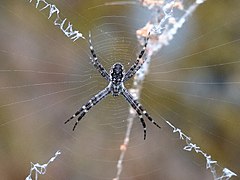
The genus Argiope includes rather large spiders that often have a strikingly coloured abdomen. These spiders are distributed throughout the world. Most countries in tropical or temperate climates host one or more species that are similar in appearance. The etymology of Argiope is from a Latin word argentum meaning silver. The carapace of Argiope species is typically covered in silvery hairs, and when crawling in the sun, they reflect it in a way that gives them a metallic, white appearance.

Orb-weaver spiders are members of the spider family Araneidae. They are the most common group of builders of spiral wheel-shaped webs often found in gardens, fields, and forests. The English word "orb" can mean "circular", hence the English name of the group. Araneids have eight similar eyes, hairy or spiny legs, and no stridulating organs.
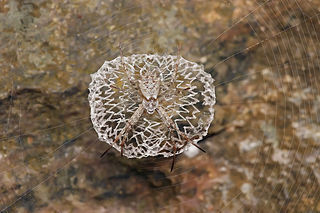
A stabilimentum, also known as a web decoration, is a conspicuous silk structure included in the webs of some species of orb-web spider. Its function is a subject of debate.

Argiope keyserlingi is a species of orb-web spider found on the east coast of Australia, from Victoria to northern Queensland. It is very similar in appearance to a closely related north Queensland species, Argiope aetherea. A. keyserlingi is commonly found in large populations in suburban parks and gardens, particularly among the leaves of Lomandra longifolia. Like many species of orb-web spider, A. keyserlingi shows considerable sexual dimorphism, as the females are many times larger than the males. Mature females can be seen during the summer, and seeing multiple males on the web of one female is not uncommon.

Argiope aetherea is a common, large orb-web spider. Like other species of Argiope, it is commonly known as the St Andrew's Cross spider, due to the characteristic cross-shaped web decorations female spiders often include in their webs. A. aetherea is similar in appearance to A. keyserlingi, however female A. aetherea are generally larger than A. keyserlingi. Like most orb-web spiders, A. aetherea shows considerable sexual size dimorphism, with females being many times larger than males.

Argiope picta is a species of orb web spider found in tropical areas of Queensland, Australia and Papua New Guinea up to the Moluccas. This species is similar in size to the sympatric Argiope aetherea; females can be distinguished from those of A. aetherea via extensive differences in abdominal colouration and patterns. The males of these two species are almost indistinguishable.

Argiope bruennichi is a species of orb-web spiders distributed throughout Central and Northern Europe, North Africa, parts of Asia, and the Azores archipelago. Like many other members of the genus Argiope, it has strikingly yellow and black markings on its abdomen.

Argiope aurantia is a species of spider, commonly known as the yellow garden spider, black and yellow garden spider, golden garden spider, writing spider, zigzag spider, zipper spider, black and yellow argiope, corn spider, Steeler spider, or McKinley spider. The species was first described by Hippolyte Lucas in 1833. It is common to the contiguous United States, Hawaii, southern Canada, Mexico, and Central America. It has distinctive yellow and black markings on the abdomen and a mostly white cephalothorax. Its scientific Latin name translates to "gilded silver-face". The body length of males range from 5–9 mm (0.20–0.35 in); females range from 19–28 mm (0.75–1.10 in). These spiders may bite if disturbed or harassed, but the venom is harmless to non-allergic humans, roughly equivalent to a bumblebee sting in intensity.

Argiope argentata, commonly known as the silver argiope or silver garden spider due to the silvery color of its cephalothorax, is a member of the orb-weaver spider family Araneidae. This species resides in arid and warm environments in North America, Central America, the Caribbean and widely across South America. In the United States, it is found at least in Southern California, Florida, Arizona, and Texas. A. argentata create stabilimenta and a unique zig-zag in its web design, and it utilizes its UV-reflecting silk to attract pollinating species to prey upon. Like other species of Argiope, its venom is not harmful to humans; however, it can be employed to immobilize its prey. A. argentata engages in sexual cannibalism either mid- or post-copulation. One aspect of particular interest regarding this species is its extinction patterns, which notably have minimal correlation with its population size but rather occur sporadically for the species.

Argiope protensa, commonly known as the tailed grass spider or teardrop spider, is a species of spider in the orb weaver family, Araneidae. This species is fairly common and widespread in Australasia, but like many spider species, little is known of its ecology, biology, or life history.
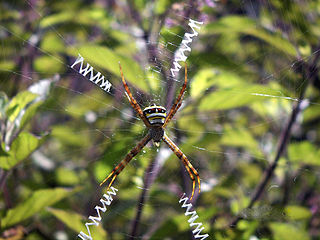
Argiope anasuja, is a species of harmless orb-weaver spider found from the Seychelles to India, Pakistan and Sri Lanka, in the Maldives and in the Brazil.
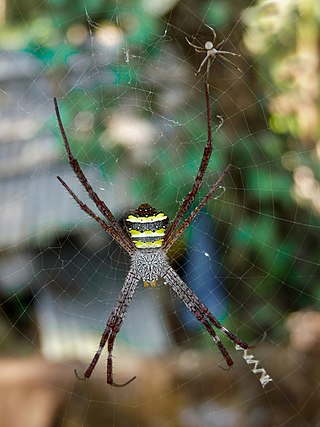
Argiope pulchella is a species of the orb-weaver spider family, Araneidae. It ranges from India to China and can be found on Java. It is a synanthropic species, often living in habitats associated with humans.
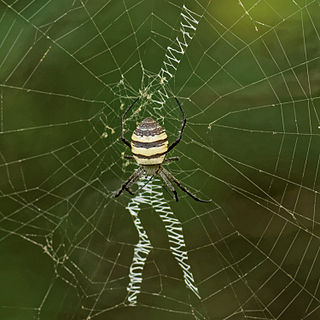
Argiope aemula, commonly known as the oval St Andrew's cross spider, is a species of spider in the family Araneidae which is native to southeast Asia, found from India and Sri Lanka to the Philippines, Indonesia, and Vanuatu. It is one of the giant, conspicuous "signature spider" species of the genus Argiope, observed in tropical and subtropical grasslands.

Argiope magnifica is a species of orb web spider found in tropical areas of north-east Queensland, Australia, eastern Papua New Guinea and the Solomon Islands. It is commonly known as the magnificent St Andrew's cross spider. This species is similar in size to the sympatric Argiope keyserlingi; females can be distinguished from those of A. keyserlingi via extensive differences in abdominal colouration and patterns. The males of these two species are almost indistinguishable.

Argiope radon is a species of orb web spider native to Australia. It is found in tropical areas of the Northern Territory, Western Australia and Queensland. It is commonly known as the Northern St Andrew's cross spider.
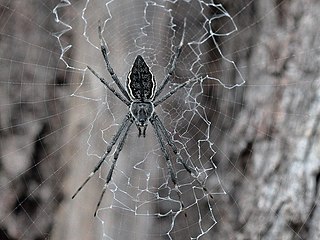
Argiope ocyaloides is a species of orb-web spider found in Queensland, Australia. It is commonly known as bark-hugging St Andrews cross spider.Argiope ocyaloides can be found in crevices of dark coloured bark on eucalypt, acacia, or similar trees. It is smaller than most other species of Argiope and is dark brown to black in colour. The abdomen of Argiope ocyaloides is long with a pointed tip whereas the similar species Argiope mascordi has a shorter abdomen with rounded tip.

Argiope versicolor, the multi-coloured Saint Andrew's cross spider, is a species of orb-weaver spider found mostly in Southeast Asia, from China to Indonesia.

Argiope katherina is a species of orb-weaver spider found in the northern parts of the Northern Territory and Western Australia. It was first described by Levi in 1983 and was named for Katherine Gorge. Specimens had been found at the mouth of split rock crevices up to one hundred metres from the Katherine River in sparse Pandanus-dominated territory.
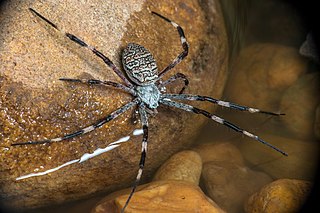
Argiope dietrichae is a rare species of orb-web spider found in the northern parts of Western Australia and the Northern Territory. It was first described by Levi in 1983, and it was named for Amalie Dietrich who collected specimens for the Godeffroy Museum in Hamburg.
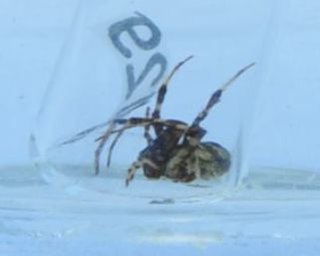
Gea eff is a species of orb-weaver spider. It is found in Papua New Guinea. The arachnologist Herbert Walter Levi formally described the species in 1983. While it was still undescribed, Michael H. Robinson and colleagues reported on its courtship and mating behaviors. Gea eff has the shortest scientific name of any spider species.


